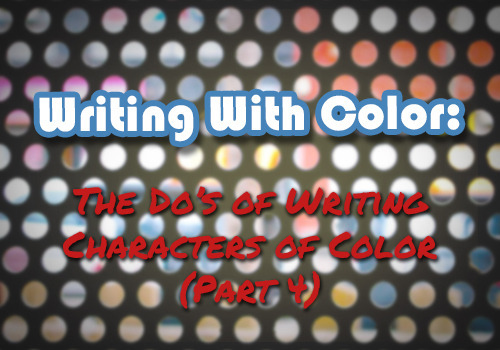The Do’s of Writing People of Color: Learn From Mistakes

Diversity makes stories better, plain and simple. This year, we’ve partnered with the good folks at Writing With Color to get some advice on how to write stories populated with people of all racial and ethnic backgrounds. In the third part of her “Do’s of Writing People of Color” sub-series, founder Colette Aburime talks about how to recover when you make mistakes:
So you’re gearing up to write some exciting, diverse stories. With all that research under the belt, your sights are set on getting it right. It’s a good mindset to have and absolutely do your best! Still, expect to overlook or misrepresent some aspects of your Characters of Color.
Maybe you included a universally accepted no-no, such as comparing a Person of Color’s skin color to food instead of more favorable words for skin tone. It could be nuances missed by not being in the group. Perhaps it’s something more subjective that some have an issue with, but others don’t mind.
How to avoid mistakes (in the first place)Ideally, you’ll avoid making huge missteps if you’ve prepared on the front end.
Before you write:
Research - Know the dos & don'ts, associated stereotypes, & culture Read stories by the groups you’ve included. How do they represent themselves?Practice - Start with small-scale projects. Get out the goofs before the stakes are high. Plan - Build a profile & backstory for your Characters of Color.Worry - Some fuss is good. It makes you double-check your story for sound representationWrite, gather feedback, and write again. Oh, and don’t forget to describe those characters so we know their background!How to handle mistakesYou put in the pre-work. Still, readers are unhappy about something you’ve written.
This is your “keep calm and carry on” wake-up call. No need to throw down the pen and vow never to write inclusively again. Stuff happens! Now you push through it.
The best place to start is to hear the readers out, say you’re sorry, and to get better.
1. ListenTake in the criticism, and keep track of their feedback. If an option, ask for clarification. You want to fully understand what was uncomfortable for the reader(s).
This is free writing advice, even if it isn’t said nicely. On the other hand, not all criticism is created equal. Feel free to ignore counterproductive feedback like “Don’t write PoC.” or anything that snubs having a diverse and humanly flawed cast of characters (Check out: Stereotyped vs Nuanced Characters and Audience Perception).
2. ApologizeYou’re not the first or the last to write something that upsets people. You’ll recover, but apologizing is essential to that. Take your blunder with grace. Acknowledge your error and the offense it has caused. Being too defensive or over explaining intent can turn an apology into a disclaimer.
3. Do betterResearch the criticism. Focus some research specifically on the issue at hand. You want to truly understand where you went wrong so you can go right next time.Gather feedback. Get a second or even third opinion. Seek people in the groups you’re writing on. Having beta-readers check over your story is key to making it better. Know your limits. If you’re not in the group, there’s no reason to pretend to know exactly what it’s like to be the person you’re writing about. It’s only natural to not know some things, and small, missed nuances are forgivable. Re-write or improve on future works. If it’s possible to mend a piece after a pretty big mistake, do it. If there’s a second installment, make things right going forward. Otherwise, show your improvement in your next pieces.It’s easy to doubt whether you should write with diversity after running into roadblocks, but don’t let a stumble keep you falling forever. To err is human, isn’t it?
All and all, worry a little and write a lot. You’ve got this.

Colette Aburime is the founder of WritingWithColor, a writing advice blog focused on diversity. She studied creative and professional writing in college, and writes (or rather, dreams of writing) in her free time. Colette is a big fan of romance and fantasy and lives out her fairytale in a humble cottage in Minnesota’s Twin Cities. She spends happily ever after with her prince, plants, and a feisty cat. Check out WritingWithColor on
Tumblr
and
Twitter
.
Chris Baty's Blog
- Chris Baty's profile
- 62 followers



